mobile View, to the German Version tap the flag


- Duchy of Saxony-Coburg-Gotha (Sachsen-Coburg-Gotha)
(bestehend aus den Herzogtümern Sachsen-Coburg und Sachsen-Gotha)
- to 1918 country of the German Empire
- 1919 separation of the country into the Free States of Coburg and Gotha
• Flags
• Meaning/Origin of the Flag
• Coat of Arms
• Meaning/Origin of the Coat of Arms
• Cockade
• Map
• Numbers and Facts
• History
• Origin of the Country's Name

to ca.1830,
Colours of the country,
Source, by: Jens Hild




ca.1830–1919,
Colours of the country und flag of the country,
Source, by: Jens Hild




ca.1888–1919,
de facto state flag,
Source, by: Jens Hild



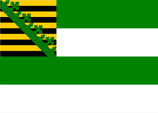
1887–1900,
Flag of the Duke,
ratio = 5:7,
Source, by: Flags of the World



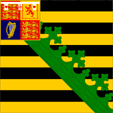
1900–1918,
Flag of the Duke,
Source, by: Flags of the World






The colors of the House Wettin are blue and yellow. They have their roots most likely in the crest of the Dominion of Landsberg. These colors were worn by members of the Swiss Guards at the electoral-saxon courts. The bands of some medals had been blue-yellow too. Black and yellow were for centuries the colours (livery color) of the Saxon courts (Albertine and Ernestine). They have their roots the regular coat of arms (black lion in golden field, which later became the arms of the Margraviate of Meissen) or in the coat of arms of the Duchy of Saxony. Black and yellow were used for certificate cords and for many military ensigns since the 17th century. However, national colors in the true sense, they were not yet.
The former Albertine electorate and new kingdom of Saxony joined the Rhine Confederation on 11th of December in 1806, on 15th of December in 1806 followed by the Ernestine duchies in Thuringia. The troops of the duchies were consolidated and equipped with cockades in black and gold in accordance with the convention of the 13th of February in 1807. The cockades of the Kingdom of Saxony remained white.
When the Saxon King Friedrich August I., of the dynasty of the Albertine Wettins, in May 1815 was returning home from captivity to Saxony after the end of the liberation wars against Napoleon, he instructed Lieutenant General of Lecoq at the 22nd of May in 1815, to reorganize and bring home, the at the River Rhine standing Saxon troops. The until this point in time white cockades on the caps of the soldiers were to surround with a green edge by this instruction of the king to avoid confusions with other troops. The news about the creation of the color combination of white and green spread very quickly, and arrived Saxony before the king. So he was received by his people with white and green garlands, flags and ribbons. In recognition of this fact, the monarch decided to use these colors instead of black and gold as the colors of the country. The Saxon duchies (Thuringia), ruled by the Ernestine Wettins took mostly over these arrangements for their colors and flags.
The Dukes of Saxony-Coburg-Gotha gradually took over this regulation, definitively until ca. 1830, namely in the arrangement of colours in green-white. However, were used in practice, even by the authorities, alreday since 1823 white-green(!) cockades, which were changed after the German War from 1866/67 to the arrangement of colours in green-white-green.
The colours of the German states are (called Landesfarben, are often derived from the colours of the coats of arms, and used as cockades, as well as flags), were formed – especially in the German inland countries – rather late, often after the French Revolution and the following wars of liberation. In the period from ca. 1815 to ca. 1830, this process was finally completed in all German states.
The colours of the small Thuringian States persisted after the abdication of the princes, even after the formation of the State of Thuringia on 5th of January in 1920, but they became territorial flags. On 25th of April in 1922 was adopted the "Regulation on the flagging of state buildings", which laid down, that the previous territorial flags have to be no longer in use. Just the abolition of the territories on 1st of April in 1923, was the end for the colours of the former Thuringian States.
A personal flag for the Duke was introduced in 1887. It showed four horizontal stripes in green and white and in the upper corner the image of the Saxon coat of arms. This flag thus resembles the personal flag of the Duke of Saxony-Meiningen, but the image of the Saxon coat of arms starts at the top with a golden stripe, aligned with the personal coat of arms of the Duke. This flag was replaced by another model in 1896 or (according to other sources) in 1900. This flag was square and showed on the complete flag the image of the Saxon coat of arms (starting at the top in black, as with the flag of the King of Saxony), but in the upper corner the heraldry of the duke as an English prince.
Source: Volker Preuß,
www.sachsenlied.de,
Jens Hild,
Flags of the World,
Deutsche Wappen Rolle


Lesser coat of arms of Saxony-Coburg-Gotha,
Source, by: Deutsche Wappen Rolle
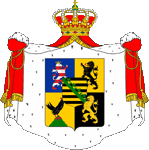
middle coat of arms of Saxony-Coburg-Gotha,
Source, by: Deutsche Wappen Rolle
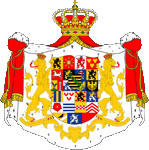
Greater coat of arms of Saxony-Coburg-Gotha,
Source, by: Deutsche Wappen Rolle

Shield of the middle coat of arms of Saxony-Coburg-Gotha,
Source, by: Deutsche Wappen Rolle
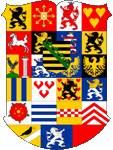
Shield of the greater coat of arms of Saxony-Coburg-Gotha,
Source, by: Deutsche Wappen Rolle

The central element of the heraldry of the Saxon monarchies is the Saxon coat of arms. It was created around 1180 when the Ascanians, margraves of Brandenburg and counts of Ballenstedt became the dukes of Saxony: a green diamond wreath was placed over the black and golden coat of arms of Ballenstedt. In principle, the title of the Duke of Saxony migrated up the Elbe to what is now central Germany, as it was lent to various noble families (last 1423 the Wettins). In 1485 the "Leipzig division" of the Wettin lands took place between the brothers Duke Albrecht (ancestor of the Albertines) and Elector Ernst (ancestor of the Ernestines). The Ernestines divided into many lines, which retained the Saxon heraldry.
About the coat of arms: The greater coat of arms (shield, shield-holders with pedestal, mantle and pavilion with crown) showed on the shield next to 23 fields, the Saxon coat of arms as heart shield. In the middle coat of arms (shield with the importantst fields and crown) the shield shows next to the Saxon coat of arms as heart shield 4 fields: Landgraviate of Thuringia and Duchy of Gotha (white and red striped lion on blue), Margraviate of Meißen (black lion with red armament on gold), County of Henneberg (black hen on a green mountain in front of a golden background) and Duchy of Coburg (golden lion on black). The lesser coat of arms (shield with crown) shows only the Saxon coat of arms with the diamond wreath. The crown is a royal crown and the imperial orb is colored in green.
Source: Volker Preuß,
Deutsche Wappen Rolle


to 1807,
Cockade of Saxony-Coburg-Gotha,
Source, by: Jens Hild

1807–1815(?),
Cockade of Saxony-Coburg-Gotha,
Source, by: Jens Hild

1823–1866/1867,
Cockade of Saxony-Coburg-Gotha,
Source, by: Jens Hild

1866/1867–1920,
Cockade of Saxony-Coburg-Gotha,
Source, by: Jens Hild
The former Albertine electorate and new kingdom of Saxony joined the Rhine Confederation on 11th of December in 1806, on 15th of December in 1806 followed by the Ernestine duchies in Thuringia. The troops of the duchies were consolidated and equipped with cockades in black and gold in accordance with the convention of the 13th of February in 1807. The cockades of the Kingdom of Saxony remained white. When the Kingdom of Saxony changed its national colors to white and green on 16th of June in 1815, the Saxon duchies in Thuringia, governed by the Ernestine Wettin family, mostly followed this rule for their national colors, flags and cockades. The arrangement of white and green was varied in different ways.
Source: Volker Preuß,
Jens Hild,
Deutsche Wappen Rolle

Read here:
Informations, history and facts about the theme "Cockades".

Cockade

The Thuringian Staates:
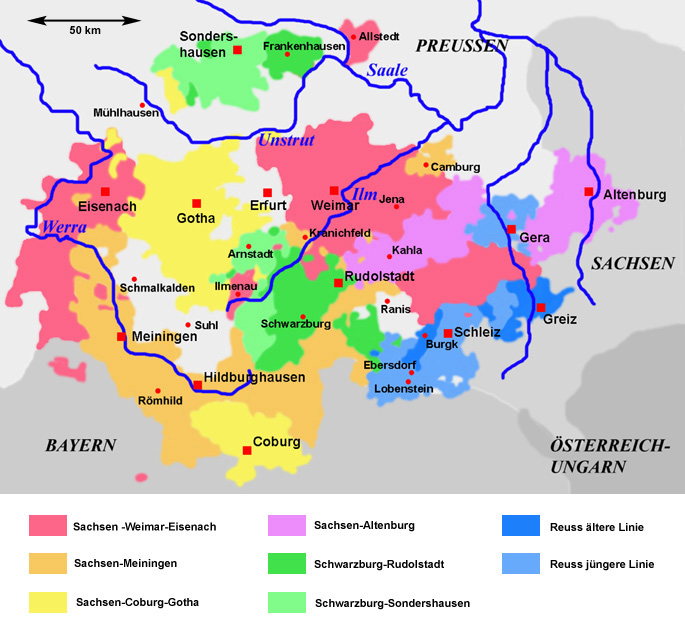
Source:
Volker Preuß
The map shows the Duchy of Saxony-Coburg-Gotha between the years 1867 and 1918 in yellow.

Area: 763 square miles
Inhabitants: 257 000 (1910)
Density of Population: 336 inh./sq.mi. (1910)
Capitals: Coburg and Gotha
Currency to 1875:
in Gotha: 1 Taler = 30 Groschen = 360 Pfennige
in Coburg: 1 Gulden = 60 Kreuzer = 240 Pfennige
Currency 1875–1918: 1 Mark = 100 Pfennig
Source: Der Michel,
Wikipedia (D)

1264 · the Landgraviate of Thuringia (then much larger) was divided after a war of succession, the Margrave of Meißen from the House of Wettin received the eastern part, the Landgraviate of Thuringia (almost all of today's Thuringia), the western part became the Landgraviate of Hesse
1342–1346 · the House Wettin can prevail against a coalition of local Thuringian counts, the counts have to take their land from the Margrave of Meißen and Landgrave of Thuringia to fief, after their extinction these areas fell to Thuringia (except Schwarzburg and Reuss)
1423 · the Margrave of Meissen, Friedrich 'the Martial', got Saxony-Wittenberg (Electorate of Saxony) as fiefdom, thereafter gradual pass of the name "Saxony" to the Margraviate of Meissen
1485 · "Leipzig Partition" of the Wettin's estates between the brethren Duke Albrecht (progenitor of the Wettin-Albertinians) and Elector Ernst (progenitor of the Wettin-Ernestinians); Duke Albrecht: County of Meissen, western Osterland, North Thuringia; Elector Ernst: Electorate of Saxony, South Thuringia, Vogtland
1547 · "Wittenberg Capitulation" the dignity of election passes from the Ernestinians to the Albertinians
1640 · Ernestine Division, Duke Wilhelm IV. divides his Duchy Saxony-Weimar into the Duchy of Saxony-Eisenach, under his brother Albrecht, and the Duchy of Saxony-Gotha, under his brother Ernst I. (the Pious)
1675 · death of Duke Ernst I. 'the Pious' of Saxony-Gotha (Ernestins), he leaves seven sons
1680 · Saxony-Gotha is divided among the seven sons, thereby creating of 7 duchies: Saxony-Gotha-Altenburg under Duke Friedrich I., Saxony-Coburg under Duke Albrecht, Saxony-Meiningen under Duke Bernhard I., Saxony-Römhild under Duke Heinrich, Saxony-Eisenberg under Duke Christian, Saxony-Hildburghausen under Duke Ernst, Saxony-Saalfeld under Duke Johann Ernst
1699 · death of Duke Albrecht of Saxony-Coburg, he leaves no heirs, inheritance disputes follow between Saxony-Meiningen, Saxony-Hildburghausen and Saxony-Saalfeld
1735 · Saxony-Coburg largely takes over the area of Saxony-Saalfeld, the Sachsen-Coburg-Saalfeld line is created
1806 · joining of Saxony-Gotha-Saalfeld to the Rhine Confederation
1815 · joining to the German Confederation
1825 · Extinction of the Saxony-Gotha-Altenburg line. In 1826 the Saxon duchies in Thuringia were reorganized by an arbitral award made by King Friedrich August I. of Saxony: The Saxony-Hildburghausen line renounces its land and takes over Saxony-Altenburg. Saxony-Coburg-Saalfeld cedes Saalfeld. The partial duchies of Hildburghausen and Saalfeld come to Saxony-Meiningen. The partial duchy of Gotha comes to Saxony-Coburg, in this way Saxony-Coburg-Gotha is created.
1826 · the Duchy of Saxony-Coburg-Gotha comes into beeing
1866 · in the Brother War on the hands of Prussia, joining to the North German Confederation
1871 · joining of the Duchy of Saxony-Coburg-Gotha to the German Empire
1918 · fall of the monarchy
1919 · separation of the country into the Free States of Coburg and Gotha
Source:
Wikipedia (D),
RetroBib Retrobibliothek,
Atlas zur Geschichte

The origin of the name "Saxony" lies in the 5th century in the old Duchy of the Saxons in what is now northwest Germany. The country was smashed by the German emperor in 1180, but the title of "Duke of Saxony" was retained. It was connected to the outskirts of the old duchy and, with the lending to various noble families, the name in principle migrated up the Elbe River to today's Saxony (the then Margraviate of Meissen under the house Wettin) in central Germany. To distinguish it from the real Saxon (the old Duchy), the Saxon of the house of Wettin was called "Upper Saxony". This remained until the term "Hanover" had prevailed for the old Saxon areas, which today are roughly summarized in "Lower Saxony".
The name "Saxony" was transferred to the Thuringian areas in 1485 when the Wettin Saxon was divided into the lines of the Albertines and Ernestines. Since the dukes rejected the promogenitur there for a long time, the duchies were often shared between all the sons, and a dense network of small partial duchies arised (named after the capital of the duchy), which had been oftenly linked to each other, which had been allocated to the various family lines. The were often inherited, partially inherited or even exchanged. This was always reflected in the name of the respective duchy. For example, Saxony-Coburg-Saalfeld ceded the partial duchy of Saalfeld and got the partial duchy of Gotha. This is how the Duchy of Saxony-Coburg-Gotha came into being, consisting of the two sub-duchies (partial duchies) of Coburg and Gotha.
The name Thuringia for the whole region has been preserved, it comes from the old Kingdom of Thuringia, which was destroyed and annexed by the Franks in the 6th century. The Duchy of Thuringia was founded in the 7th century, which in turn only lasted for one century. This was not a tribal duchy, however, since the Thuringians no longer existed. In 1131 the later Emperor Lothar III. established the Landgraviate of Thuringia and gave it to the House of the Ludovingians, who died out in 1247. The country was divided in 1264 after a war of succession between the House of Wettin (as the Landgraviate of Thuringia) and the House of Brabant (as the Landgraviate of Hesse).
Source: Volker Preuß









![]()




























